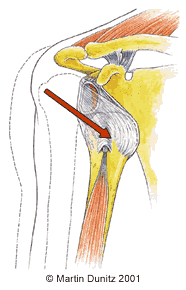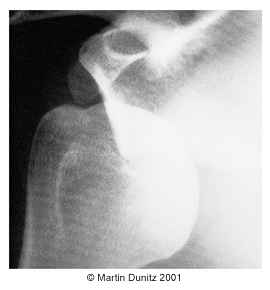Dislocated Shoulder in Depth
AKA: Shoulder Dislocation
| Common Signs & Symptoms | |||||
| Pain | Swelling | Stiffness | Weakness | Instability | Locking |
Dislocated Shoulder Injury Explained
A Dislocated Shoulder is a common shoulder injury in contact sports such as rugby and martial arts. Shoulder dislocations are characterised by severe shoulder pain and hospital treatment is required to restore normal shoulder anatomy.
The shoulder is a ball-and-socket joint that has a large range of movement but not a lot of stability, which makes the shoulder joint prone to dislocation. The shoulder is particularly unstable when it is rotated outwards and the arm cocked back or ‘abducted’. Any additional force in this position will cause the head of the Humerus (arm) bone to come out of the joint in a forward direction. This is referred to as an anterior dislocation.


The shoulder joint is enclosed by a fibrous capsule which is strengthened by ligaments that provide a reinforced thickening of the capsule. The joint also has a labrum – a fibrocartilage lip that increases the stability of the joint. In the case of a dislocation due to trauma (such as a fall or collision), the joint capsule and ligaments are usually torn, and the labrum may also be damaged.
Dislocated Shoulder Signs & Symptoms
The most obvious symptom is shoulder pain. A person with a dislocated shoulder will be unable to move the affected shoulder and will hold the arm protectively against the chest. The normal rounded appearance of the shoulder will be replaced by a more squared-off edge because the head of the Humerus bone drops downwards. If a dislocation is suspected, an x-ray should be taken to confirm the damage.
Dislocated Shoulder Treatment
What you can do
| Consult a sports injury expert | |
| Apply ice packs/cold therapy to relieve pain & reduce bleeding | |
| Use resistance bands for strengthening exercises | |
| Wear a shoulder support for reassurance |
It is important that a shoulder dislocation is seen quickly by a doctor who can put the joint back in place. This is because the position of the Humerus in a dislocated shoulder joint can cause damage to the Axillary nerve. This can lead to a loss of sensation and muscle strength in the affected arm. Pain relieving medication prescribed by a doctor can help to relieve the shoulder pain.
Ice Packs can be applied to the injured shoulder for 20 minutes every two hours (never apply ice directly to the skin). The Ice Packs relieve pain and reduce bleeding in the damaged tissue. The Aircast Cryo/Cuff is the most effective method of providing ice therapy and is the professional’s choice for shoulder injuries. It can provide continuous ice cold water and compression for up to 8 hours and significantly reduce shoulder pain and swelling.
Once the shoulder has been put back in place it is immobilised using a sling. The sling is kept on for about 2 to 3 weeks, during which time it is important that the elbow, wrist and fingers are kept moving to prevent them stiffening up.
Active rehabilitation is started as soon as possible but overhead arm movement and sporting activity should be avoided for at least 6 weeks. Gentle range of movement exercises under the supervision of a Chartered Physiotherapist can be started once the sling is removed. Strengthening exercises for the Rotator Cuff muscles should be started as soon as they can be done without pain. These can be done at home using Resistance Bands. Functional movements such as inward and outward rotation can easily be achieved with resistance bands, start off with light resistance and progress to heavier duty bands as pain and range of movement allows.
Because of the damage to the structures surrounding the shoulder, there is a high chance of recurrent dislocation. Surgery on an unstable shoulder is usually required after four dislocations.
Following a shoulder dislocation and shoulder surgery, many people find that a Neoprene Shoulder Support helps to provide added reassurance. They also assist with shoulder stability by providing sensory input that improves shoulder proprioception.
Dislocated Shoulder Prevention
Once there has been a dislocation of the shoulder, the joint will have a degree of instability and will be more likely to dislocate again, or become subluxed (where it moves slightly but not fully out of joint). This is because the ligaments, capsule and labrum have all been overly stretched and are damaged and cannot restrain the humeral head and prevent dislocation. In order to prevent dislocation, the Rotator Cuff muscles that surround the humeral head should be strengthened.
The Rotator Cuff muscles (Subscapularis, Supraspinatus, Infraspinatus and Teres minor) are small muscles situated around the shoulder joint. Although they have individual actions, their main role is to work together to stabilise the humeral head (ball) in the shoulder socket. Exercises using a Resistance Band can be very effective at strengthening the Rotator Cuff and maintaining shoulder stability.


